Turbidity strongly correlated with TSS and ISS
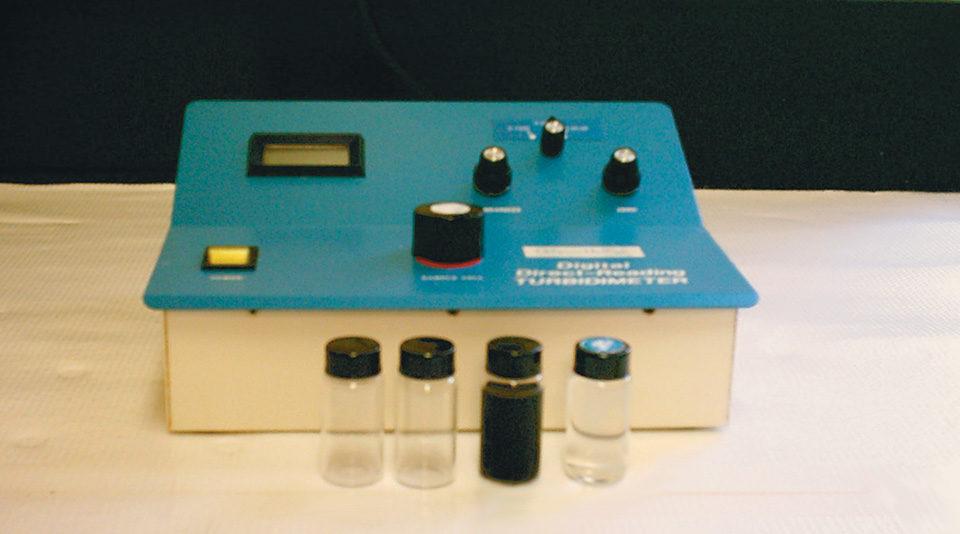
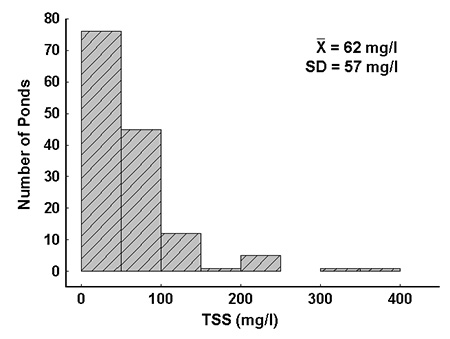
Evaluations of water quality variables in aquaculture pond effluents suggest that total suspended solids (TSS) concentration is the variable in aquaculture effluents most likely to exceed normally allowable limits for pollutants. Suspended solids in ponds consist primarily of living plankton, organic detritus, and suspended mineral particles. However, there is little data on the relative proportions of organic and inorganic particles suspended in pond water. Organic particles have a much greater pollution potential than mineral particles because they contribute to oxygen demand.
TSS concentration is time-consuming to measure, but turbidity has been used to estimate TSS concentrations in some types of effluents. A study by the authors supported by funds from the Southern Regional Aquaculture Center in Stoneville, Mississippi, USA, measured the concentrations of total, organic, and inorganic suspended solids in channel catfish ponds to determine if suspended solids concentrations could be estimated reliably from turbidity determinations.
Study methods
Water samples were collected from channel catfish ponds at the Auburn University Fisheries Research Unit in Auburn, Alabama, USA, and commercial catfish ponds in west-central Alabama during 2001. All ponds were stocked at 10,000 to 15,000 fish per hectare. Pelleted fish feed was provided daily and management was typical of that generally applied on catfish farms in Alabama.
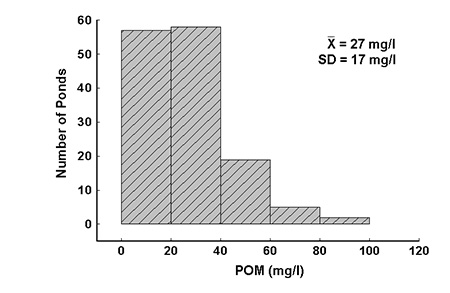
Samples were dipped from pond surfaces and placed in 1-liter plastic bottles. Samples from the Fisheries Research Unit were transported to the laboratory and analyses were initiated within two hours after collection. Samples dipped from the commercial ponds were placed on ice and transported to Auburn University, where analyses were initiated within six hours after collection.
Analyses for total suspended solids involved determining the weight of residue retained on a glass fiber filter. Particulate organic matter (POM) was estimated as the weight loss of the residue on the filters remaining from the TSS analysis following incineration for two hours in a muffle furnace. Inorganic suspended solids (ISS) concentration was calculated by subtracting particulate organic matter values from total suspended solids.
Turbidity was measured by nephelometry and reported in nephelometer turbidity units (NTU). The analyses followed a protocol suggested by Clesceri et al. (1998). Means and standard errors were calculated for each variable for the samples obtained during spring, summer, and fall seasons. Regression analyses among the variables were conducted and graphed.
Results
Total suspended solids
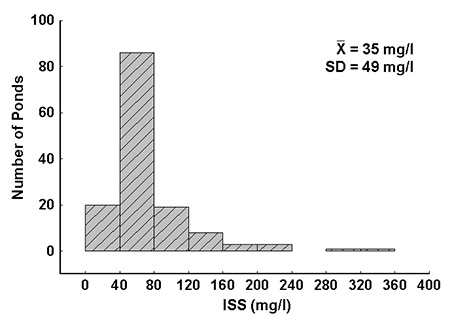
Concentrations of TSS ranged 2 to 380 milligrams per liter, with an average and standard deviation of 62 57 milligrams per liter (Fig. 1). The limit for TSS in effluent permits often is about 50 milligrams per liter, and 46 percent of the samples exceeded this concentration. This confirmed the opinions of Schwartz and Boyd (1994b) and Boyd et al. (2000) that TSS concentration is likely to be the key variable in aquaculture pond effluent regulations.
Particulate organic matter
Values for POM ranged 0 to 97 milligrams per liter. Average values and standard deviation were 28 17 milligrams per liter (Fig. 2). Most POM concentrations were below 40 milligrams per liter, and this variable comprised on average 43.5 percent of the TSS. Thus, ISS accounted for a little over half of the TSS.
ISS averaged 35 milligrams per liter with a standard deviation of 49 milligrams per liter (Fig. 3). Most samples contained less than 50 milligrams per liter ISS, but concentrations up to 317 milligrams per liter were measured. This data confirmed earlier work by Masuda and Boyd (1994a) that suggested the water of catfish ponds has nearly equal proportions of organic and inorganic suspended solids. Because planktonic organisms have an ash content of 10 to 20 percent of dry weight, an average of 3 to 6 percent of the ISS represents mineral matter in plankton cells rather than suspended mineral particles.
Turbidity
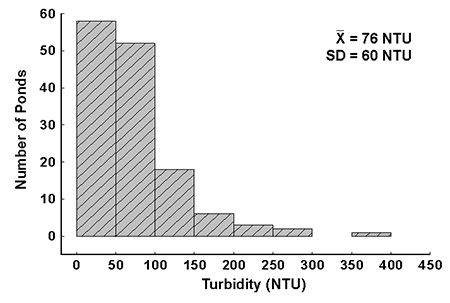
Alabama. n = 141.
Turbidity concentrations ranged 4-368 NTU, with an average and standard deviation of 76 ± 60 NTU (Fig. 4). Concentration limits for turbidity in effluents often are set at 25 or 50 NTU by the United States Environmental Protection Agency. Thus turbidity can also be a key issue in aquaculture pond effluents.
Seasonal variability
The data in Figs. 1 to 4 is for samples taken in spring, summer, and fall. If averaged by season, TSS, ISS and turbidity were lower in the spring than the summer and fall (Table 1). POM concentrations did not differ with season. The TSS concentrations increased in summer and fall, possibly as a result of the suspension of soil particles by mechanical aeration, which is not used as much in the spring as during the hot weather in summer and early fall.
Ozbay, Seasonal values for total suspended solids (TSS), Table 1
| Season | n | TSS (mg/l) | ISS (mg/l) | POM (mg/l) | Turbidity (NTU) |
|---|---|---|---|---|---|
| Spring | 15 | 20.7 ± 6.16 | 7.3 ± 2.39 | 14.2 ± 4.45 | 24.4 ± 2.90 |
| Summer | 78 | 65.7 ± 6.70 | 35.7 ± 5.88 | 30.2 ± 1.98 | 82.2 ± 7.00 |
| Fall | 48 | 68.9 ± 8.27 | 41.2 ± 7.12 | 28.6 ± 2.04 | 81.0 ± 8.52 |
The POM concentrations were related to the abundance of plankton, which can be as abundant in spring as summer and fall. Overflow from ponds occurs mostly in the spring, but ponds can be drained at any time during the year. These results showed that the overflow water following heavy rains in the spring was of relatively high quality and less likely to impair stream water quality than effluents released in summer or fall.
Relationships among variables
Turbidity was strongly correlated with TSS and ISS, and could be used as a predictor of these two variables. The regression between turbidity and POM was significant, but the relationship was too weak to be of much predictive value.
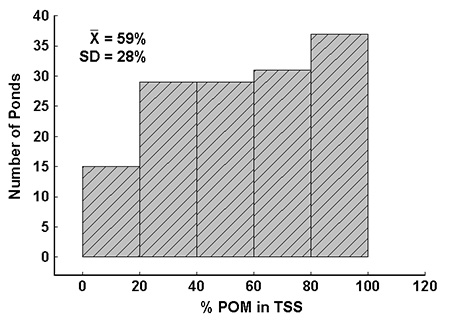
total suspended solids distribution. n = 141.
There were much stronger relationships between TSS and ISS than TSS and POM (Fig. 5). This suggested there was a more constant concentration of ISS as compared to POM. This is reasonable, for plankton blooms are famous for their tendency to fluctuate in concentrations over time.
Conclusion
The results of this study clearly showed that turbidity, ISS, and TSS should be given careful consideration in evaluations of aquaculture effluents and in developing concentration limits for water quality variables in aquaculture effluent standards. However, the three variables are closely related, and turbidity can be used to estimate both TSS and ISS concentrations. Perhaps turbidity is more appropriate for use in water quality standards than TSS and ISS, because it is easier to measure.
Note: Cited references are available from the authors.
(Editor’s Note: This article was originally published in the August 2003 print edition of the Global Aquaculture Advocate.)
Now that you've reached the end of the article ...
… please consider supporting GSA’s mission to advance responsible seafood practices through education, advocacy and third-party assurances. The Advocate aims to document the evolution of responsible seafood practices and share the expansive knowledge of our vast network of contributors.
By becoming a Global Seafood Alliance member, you’re ensuring that all of the pre-competitive work we do through member benefits, resources and events can continue. Individual membership costs just $50 a year.
Not a GSA member? Join us.
Authors
-
Gulnihal Ozbay
Department of Fisheries and Allied Aquacultures
Auburn University
Auburn, Alabama 36849 USA -
Claude E. Boyd, Ph.D.
Department of Fisheries and Allied Aquacultures
Auburn University
Auburn, Alabama 36849 USA[117,100,101,46,110,114,117,98,117,97,64,49,101,99,100,121,111,98]
Tagged With
Related Posts
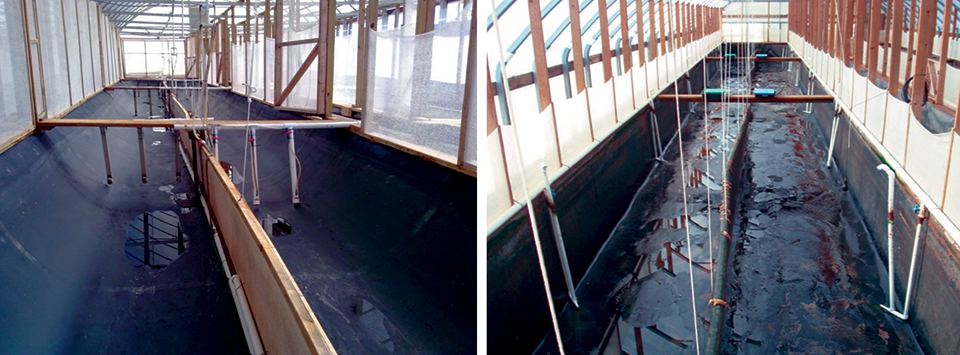
Responsibility
Advances in super-intensive, zero-exchange shrimp raceways
Research at the Texas AgriLife Research Mariculture Laboratory is investigating ways to improve the economic viability of super-intensive raceways for shrimp production.
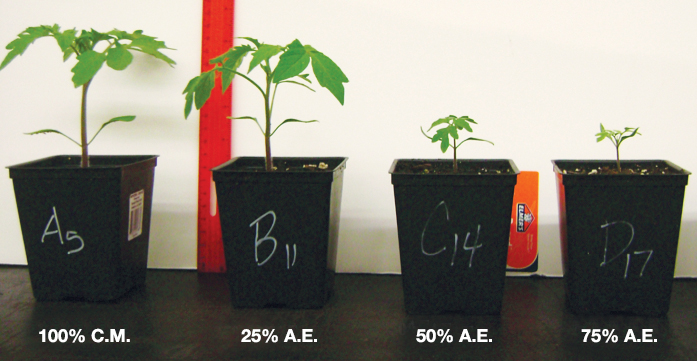
Responsibility
Aquaculture effluent partially replaces growing mix for plant production
Aquaculture effluent can be an effective fertilizer in land-based plant production. Research with tilapia utilized dewatered aquaculture effluent (A.E.) as a partial substrate replacement for tomato plant seedlings. Seedling growth decreased when effluent replaced a commercial growing mix at 25 percent or more.
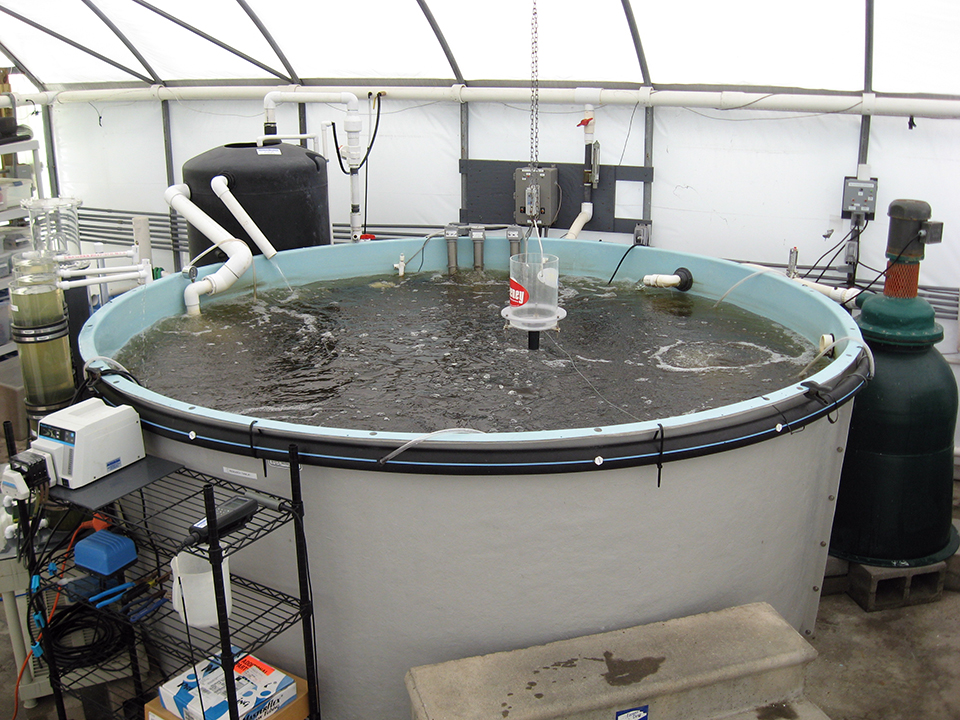
Responsibility
Biofilter start-up problems? Just add sugar!
One way to jump start biofilter operation is by adding sugar, which can provide sufficient organic carbon to neutralize the ammonia-nitrogen produced.
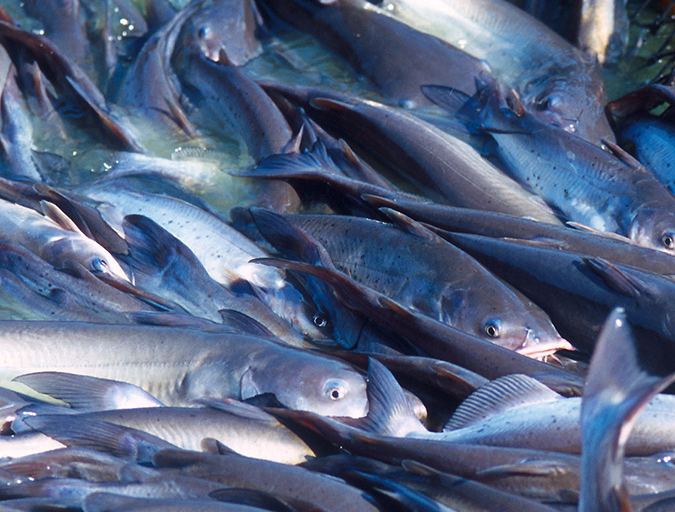
Intelligence
Biofloc technology production promising in temperate zones
A study was conducted to assess the feasibility to grow Channel catfish (Ictalurus punctatus) in an outdoor biofloc system during winter in a temperate zone. High biomasses of market-size channel catfish were successfully maintained through the winter with high survival and in good condition in both treatments.


